High Sensitivity and Wide Strain Range Flexible Strain Sensor Based on CB/CNT/PDA/TPU Conductive Fiber Membrane
Abstract
1. Introduction
2. Materials and Methods
2.1. Materials
2.2. Preparation of TPU Nanofiber Membrane
2.3. PDA-Modified TPU Nanofiber Membrane
2.4. Preparation of CB/CNT/PDA/TPU Flexible Strain Sensor
2.5. Characteristics
3. Results
3.1. Fabrication of CB/CNT/PDA/TPU Flexible Strain Sensors
3.2. Morphology and Structure of the Fiber Membrane
3.3. Mechanical Properties
3.4. Electrical Properties
3.5. Monitoring Human Behavior
4. Conclusions
Author Contributions
Funding
Institutional Review Board Statement
Informed Consent Statement
Data Availability Statement
Conflicts of Interest
References
- Ha, M.; Lim, S.; Ko, H. Wearable and flexible sensors for user-interactive health-monitoring devices. J. Mater. Chem. B 2018, 6, 4043–4064. [Google Scholar] [CrossRef] [PubMed]
- Shi, Y.; Lu, X.; Zhao, J.; Wang, W.; Meng, X.; Wang, P.; Li, F. Flexible Capacitive Pressure Sensor Based on Microstructured Composite Dielectric Layer for Broad Linear Range Pressure Sensing Applications. Micromachines 2022, 13, 223. [Google Scholar] [CrossRef] [PubMed]
- Bang, J.; Chun, B.; Lim, J.; Han, Y.; So, H. Ultra-Broad Linear Range and Sensitive Flexible Piezoresistive Sensor Using Reversed Lattice Structure for Wearable Electronics. ACS Appl. Mater. Interfaces 2023, 15, 34120–34131. [Google Scholar] [CrossRef] [PubMed]
- Zhong, M.J.; Zhang, L.J.; Liu, X.; Zhou, Y.N.; Zhang, M.Y.; Wang, Y.J.; Yang, L.; Wei, D. Wide linear range and highly sensitive flexible pressure sensor based on multistage sensing process for health monitoring and human-machine interfaces. Chem. Eng. J. 2021, 412, 128649. [Google Scholar] [CrossRef]
- Rana, V.; Gangwar, P.; Meena, J.S.; Ramesh, A.K.; Bhat, K.N.; Das, S.; Singh, P. A highly sensitive wearable flexible strain sensor based on polycrystalline MoS2 thin film. Nanotechnology 2020, 31, 385501. [Google Scholar] [CrossRef]
- Kim, J.; Lee, E.; Mehta, G.; Choi, W. Stable and high-performance piezoelectric sensor via CVD grown WS2. Nanotechnology 2020, 31, 445203. [Google Scholar] [CrossRef]
- Alsaadi, A.; Shi, Y.; Pan, L.; Tao, J.; Jia, Y. Vibration energy harvesting of multifunctional carbon fibre composite laminate structures. Compos. Sci. Technol. 2019, 178, 1–10. [Google Scholar] [CrossRef]
- Wang, B.; Wang, J.; Lou, Y.Y.; Ding, S.S.; Jin, X.; Liu, F.; Xu, Z.J.; Ma, J.Y.; Sun, Z.M.; Li, X.Y. Halloysite nanotubes strengthened electrospinning composite nanofiber membrane for on-skin flexible pressure sensor with high sensitivity, good breathability, and round-the-clock antibacterial activity. Appl. Clay Sci. 2022, 228, 106650. [Google Scholar] [CrossRef]
- Wang, X.J.; Xue, R.; Li, M.Z.; Guo, X.Y.; Liu, B.; Xu, W.G.; Wang, Z.; Liu, Y.Q.; Wang, G.H. Strain and stress sensing properties of the MWCNT/TPU nanofiber film. Surf. Interfaces 2022, 32, 102132. [Google Scholar] [CrossRef]
- Cai, M.; He, H.; Zhang, X.; Yan, X.; Li, J.; Chen, F.; Yuan, D.; Ning, X. Efficient Synthesis of PVDF/PI Side-by-Side Bicomponent Nanofiber Membrane with Enhanced Mechanical Strength and Good Thermal Stability. Nanomaterials 2018, 9, 39. [Google Scholar] [CrossRef]
- Tong, L.; Wang, X.X.; He, X.X.; Nie, G.D.; Zhang, J.; Zhang, B.; Guo, W.Z.; Long, Y.Z. Electrically Conductive TPU Nanofibrous Composite with High Stretchability for Flexible Strain Sensor. Nanoscale Res. Lett. 2018, 13, 86. [Google Scholar] [CrossRef] [PubMed]
- Wang, C.Y.; Ma, C.G.; Han, Z.P.; Li, M.N.; Lu, S.N.; Dai, P.B. Improving performance of AgNPs/PDA/TPU electrospun composite film based flexible pressure sensor by hot imprinted microstructure array. Sens. Actuators A Phys. 2024, 376, 115631. [Google Scholar] [CrossRef]
- Liu, H.; Gao, J.; Huang, W.; Dai, K.; Zheng, G.; Liu, C.; Shen, C.; Yan, X.; Guo, J.; Guo, Z. Electrically conductive strain sensing polyurethane nanocomposites with synergistic carbon nanotubes and graphene bifillers. Nanoscale 2016, 8, 12977–12989. [Google Scholar] [CrossRef]
- Lin, L.; Liu, S.; Zhang, Q.; Li, X.; Ji, M.; Deng, H.; Fu, Q. Towards tunable sensitivity of electrical property to strain for conductive polymer composites based on thermoplastic elastomer. ACS Appl. Mater. Interfaces 2013, 5, 5815–5824. [Google Scholar] [CrossRef]
- Haghgoo, M.; Ansari, R.; Hassanzadeh-Aghdam, M.K.; Jang, S.-H.; Nankali, M. Analytical modeling of synergistic carbon nanotube/carbon black effects on the sensitivity of nanocomposite strain sensors. Compos. Part A Appl. Sci. Manuf. 2023, 173, 107711. [Google Scholar] [CrossRef]
- Tian, Y.; Huang, M.; Wang, Y.; Zheng, Y.; Yin, R.; Liu, H.; Liu, C.; Shen, C. Ultra-stretchable, sensitive and breathable electronic skin based on TPU electrospinning fibrous membrane with microcrack structure for human motion monitoring and self-powered application. Chem. Eng. J. 2024, 480, 147899. [Google Scholar] [CrossRef]
- Wang, J.; Liu, S.; Chen, Z.; Shen, T.; Wang, Y.; Yin, R.; Liu, H.; Liu, C.; Shen, C. Ultrasensitive electrospinning fibrous strain sensor with synergistic conductive network for human motion monitoring and human-computer interaction. J. Mater. Sci. Technol. 2025, 213, 213–222. [Google Scholar] [CrossRef]
- Wang, C.F.; Zhao, J.; Ma, C.; Sun, J.L.; Tian, L.; Li, X.Y.; Li, F.T.; Han, X.; Liu, C.T.; Shen, C.Y.; et al. Detection of non-joint areas tiny strain and anti-interference voice recognition by micro-cracked metal thin film. Nano Energy 2017, 34, 578–585. [Google Scholar] [CrossRef]
- Huang, J.; Zhou, J.; Luo, Y.; Yan, G.; Liu, Y.; Shen, Y.; Xu, Y.; Li, H.; Yan, L.; Zhang, G.; et al. Wrinkle-Enabled Highly Stretchable Strain Sensors for Wide-Range Health Monitoring with a Big Data Cloud Platform. ACS Appl. Mater. Interfaces 2020, 12, 43009–43017. [Google Scholar] [CrossRef]
- Cho, H.; Lee, G.; Tsukruk, V.V.; Kim, S. Reduced graphene oxide/silk fibroin/cellulose nanocrystal-based wearable sensors with high efficiency and durability for physiological monitoring. Cellulose 2023, 30, 6435–6456. [Google Scholar] [CrossRef]
- Wang, X.Z.; Sun, H.L.; Yue, X.Y.; Yu, Y.F.; Zheng, G.Q.; Dai, K.; Liu, C.T.; Shen, C.Y. A highly stretchable carbon nanotubes/thermoplastic polyurethane fiber-shaped strain sensor with porous structure for human motion monitoring. Compos. Sci. Technol. 2018, 168, 126–132. [Google Scholar] [CrossRef]
- Yu, Y.F.; Zhai, Y.; Yun, Z.G.; Zhai, W.; Wang, X.Z.; Zheng, G.Q.; Yan, C.; Dai, K.; Liu, C.T.; Shen, C.Y. Ultra-Stretchable Porous Fiber-Shaped Strain Sensor with Exponential Response in Full Sensing Range and Excellent Anti-Interference Ability Toward Buckling, Torsion, Temperature, and Humidity. Adv. Electron. Mater. 2019, 5, 1900538. [Google Scholar] [CrossRef]
- Wang, C.Y.; Li, X.; Gao, E.L.; Jian, M.Q.; Xia, K.L.; Wang, Q.; Xu, Z.P.; Ren, T.L.; Zhang, Y.Y. Carbonized Silk Fabric for Ultrastretchable, Highly Sensitive, and Wearable Strain Sensors. Adv. Mater. 2016, 28, 6640–6648. [Google Scholar] [CrossRef] [PubMed]
- Zhao, X.X.; Guo, H.; Ding, P.; Zhai, W.; Liu, C.T.; Shen, C.Y.; Dai, K. Hollow-porous fiber-shaped strain sensor with multiple wrinkle-crack microstructure for strain visualization and wind monitoring. Nano Energy 2023, 108, 108197. [Google Scholar] [CrossRef]
- Wang, X.; Meng, S.; Tebyetekerwa, M.; Li, Y.; Pionteck, J.; Sun, B.; Qin, Z.; Zhu, M. Highly sensitive and stretchable piezoresistive strain sensor based on conductive poly(styrene-butadiene-styrene)/few layer graphene composite fiber. Compos. Part A Appl. Sci. Manuf. 2018, 105, 291–299. [Google Scholar] [CrossRef]
- Fu, N.; Liu, H.; Zhang, J.; Wang, S.; Yang, Y.; Chen, K.; Deng, Z. Bioinspired multifunctional MXene-decorated textile for thermal management, durable self-cleaning, bio-protection and wearable strain sensor. Appl. Surf. Sci. 2024, 669, 160607. [Google Scholar] [CrossRef]
- Wang, Y.; Li, W.; Li, C.; Zhou, B.; Zhou, Y.; Jiang, L.; Wen, S.; Zhou, F. Fabrication of ultra-high working range strain sensor using carboxyl CNTs coated electrospun TPU assisted with dopamine. Appl. Surf. Sci. 2021, 566, 150705. [Google Scholar] [CrossRef]
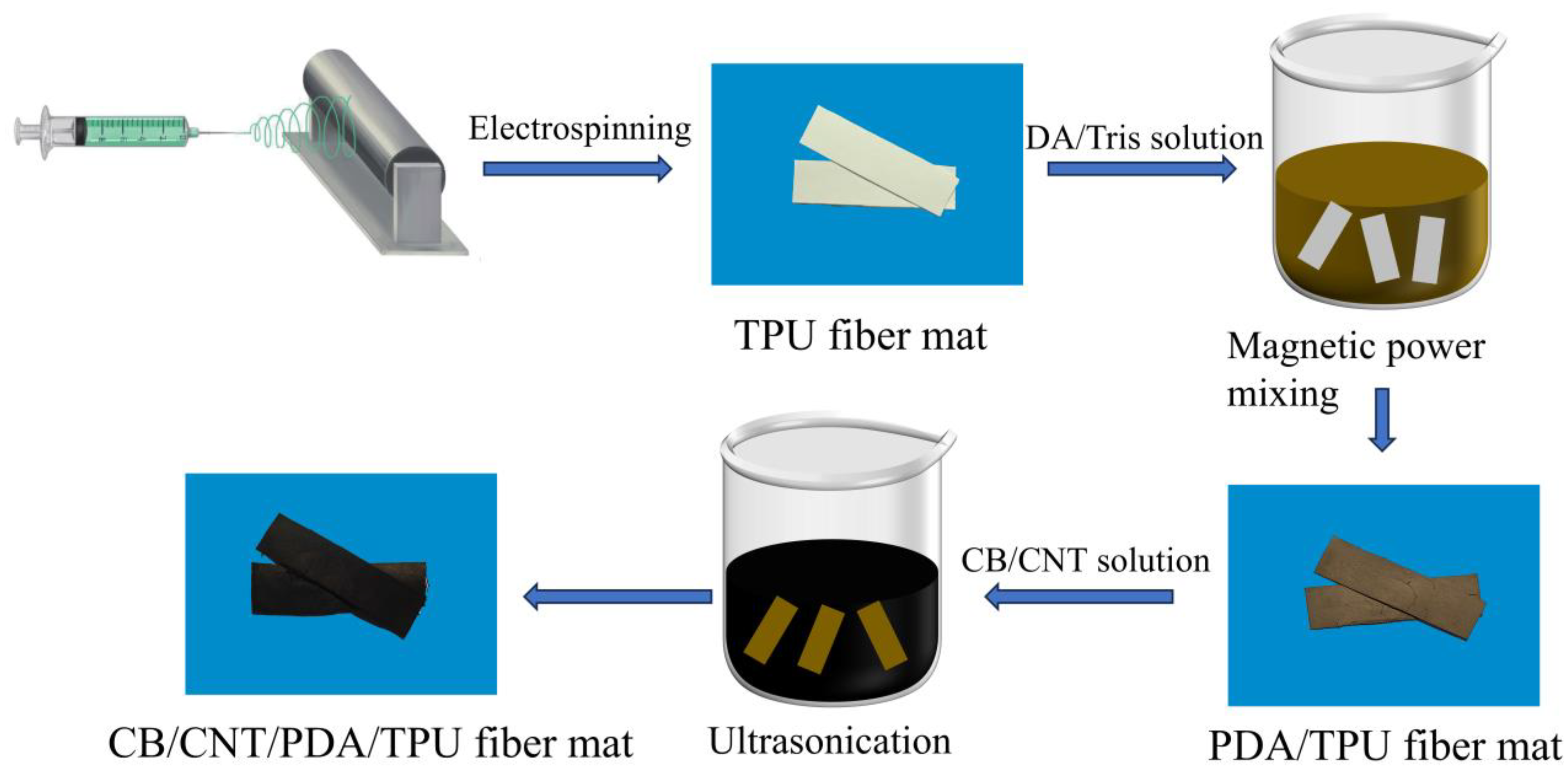
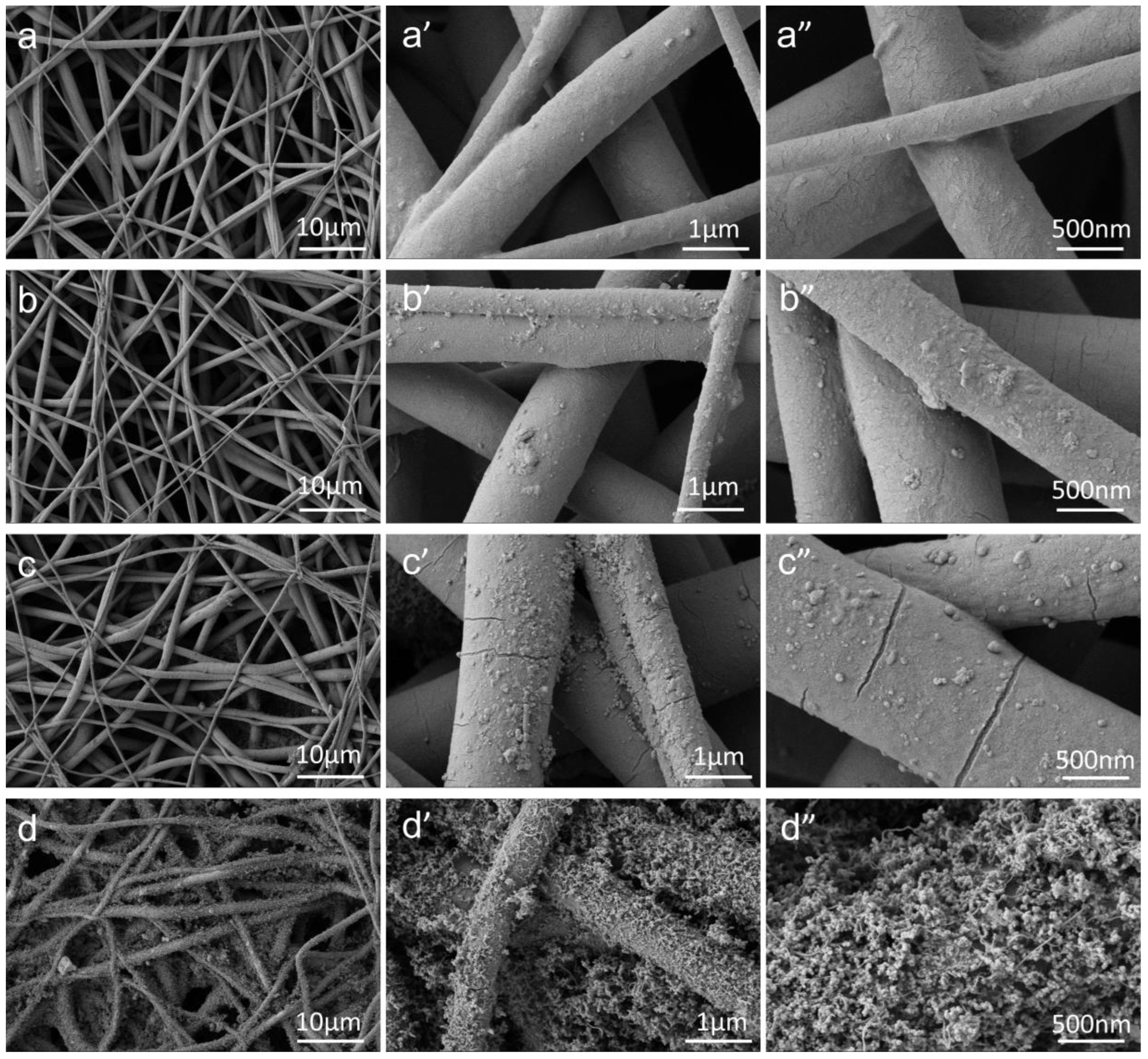
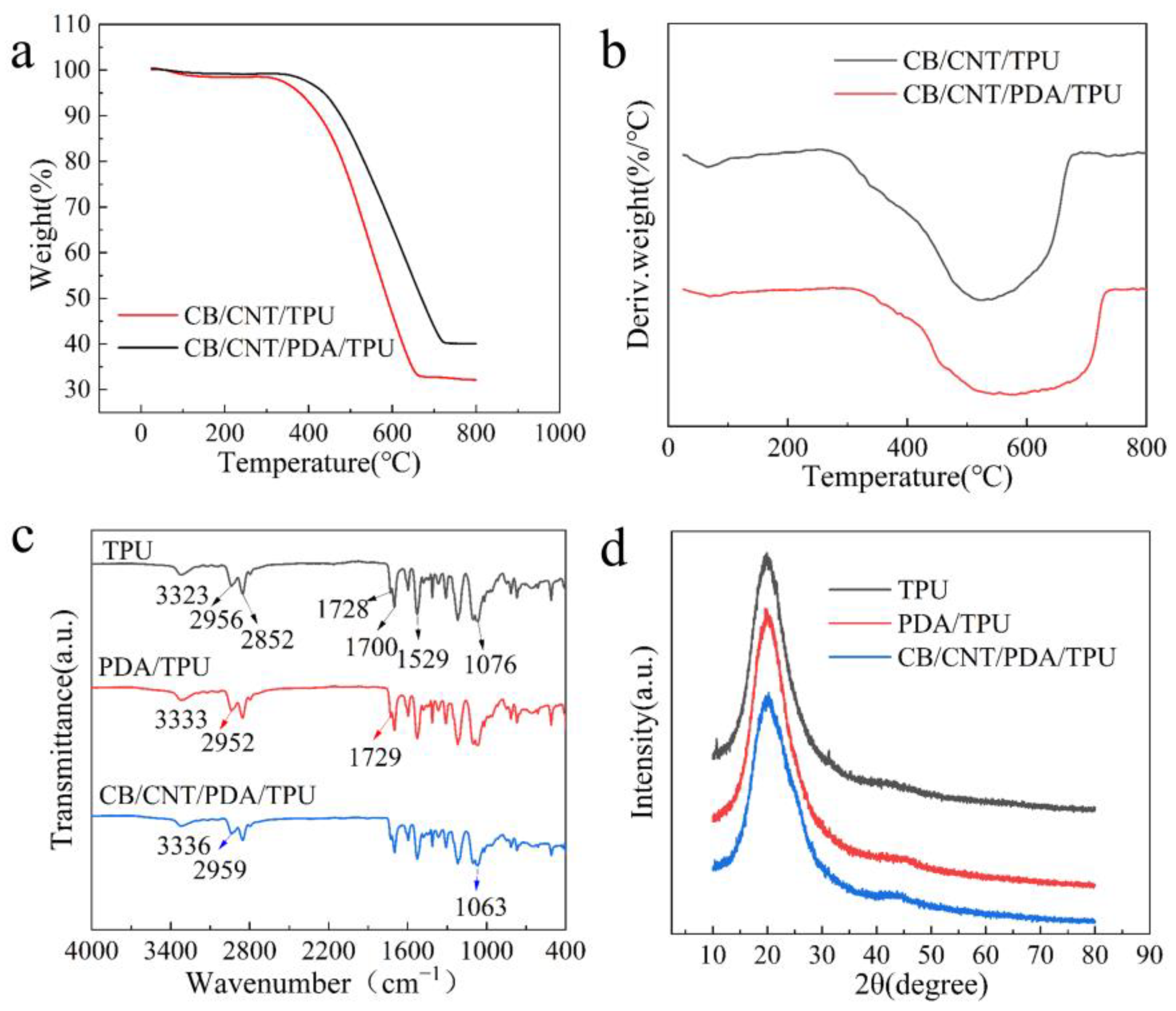
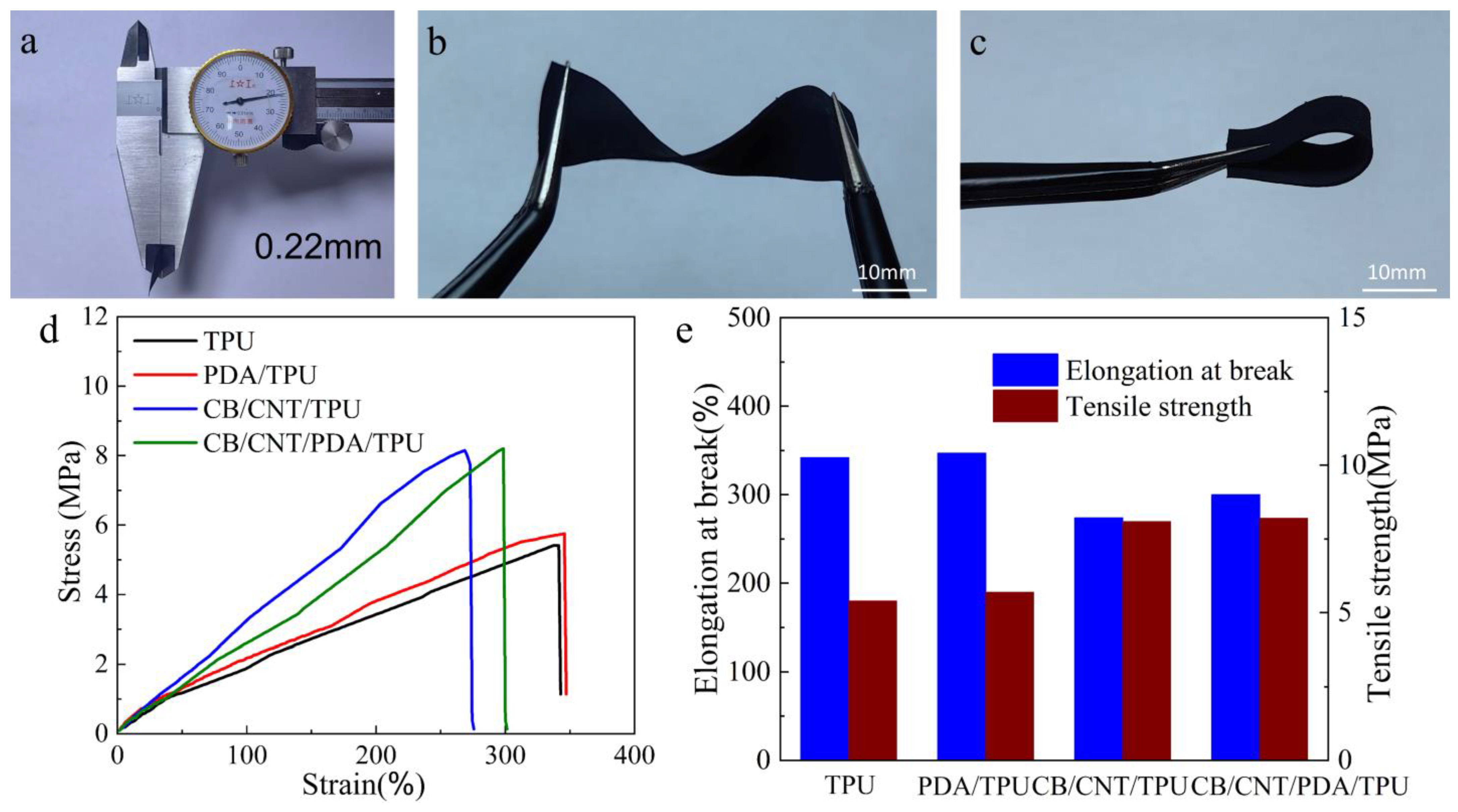
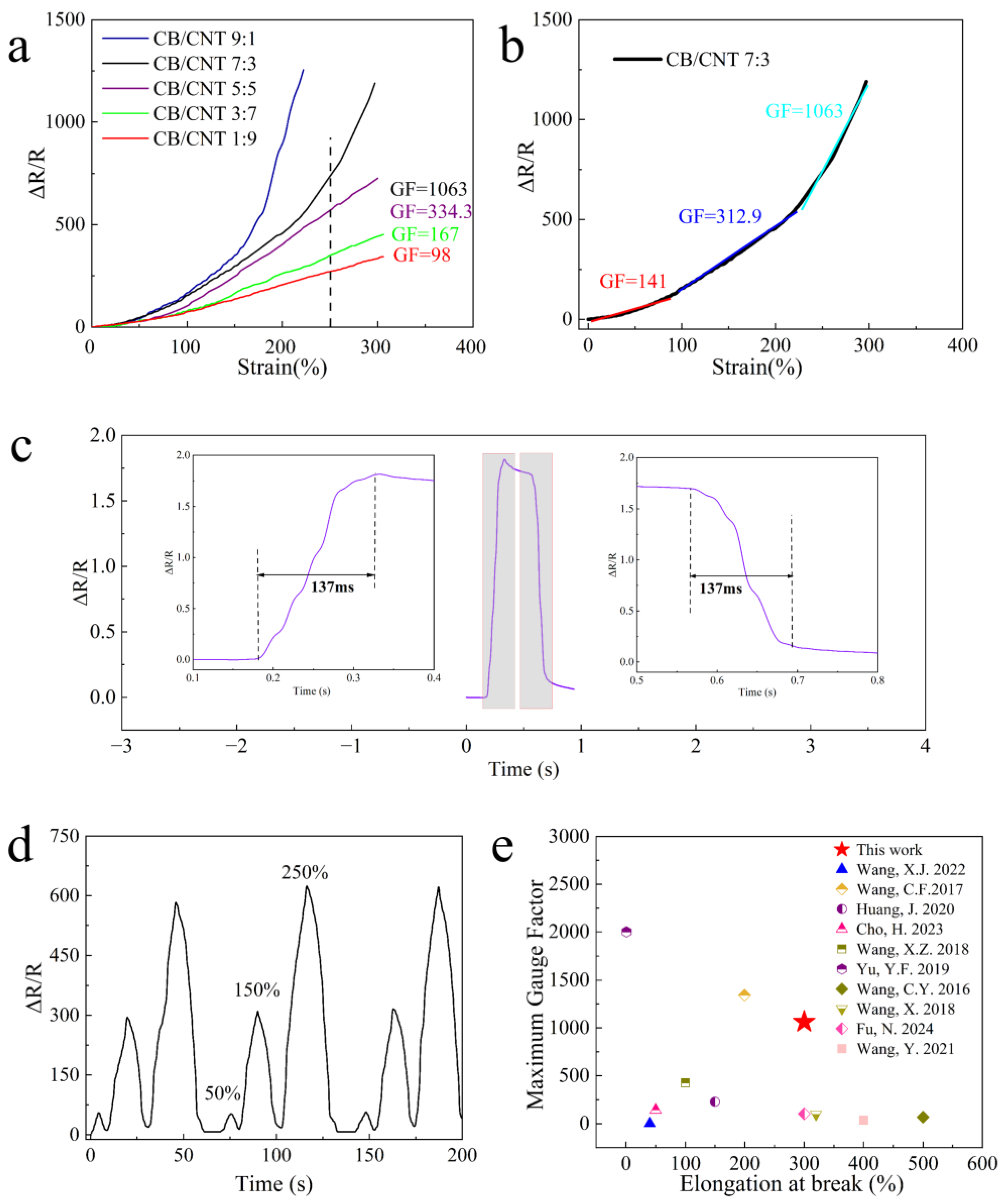
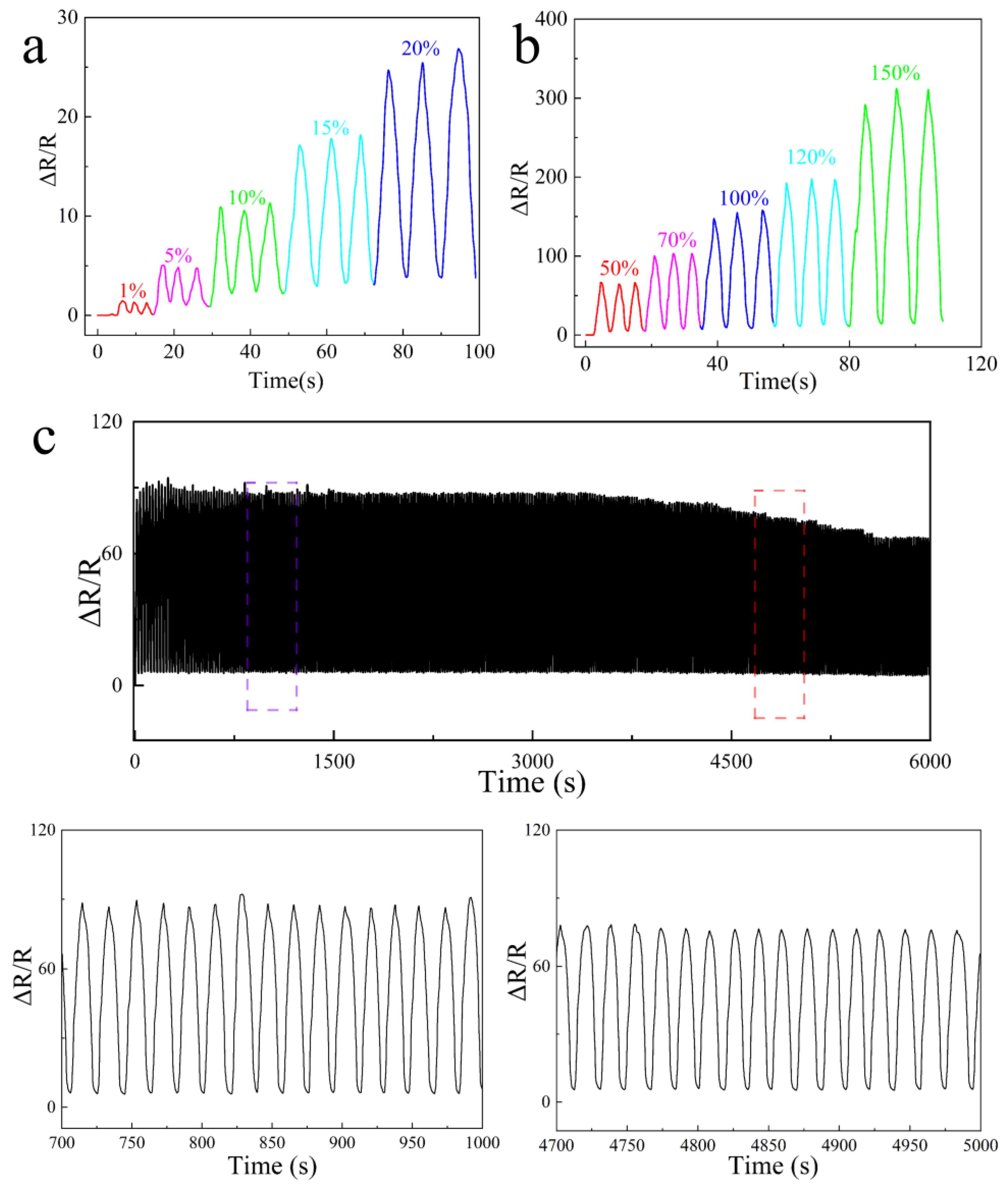
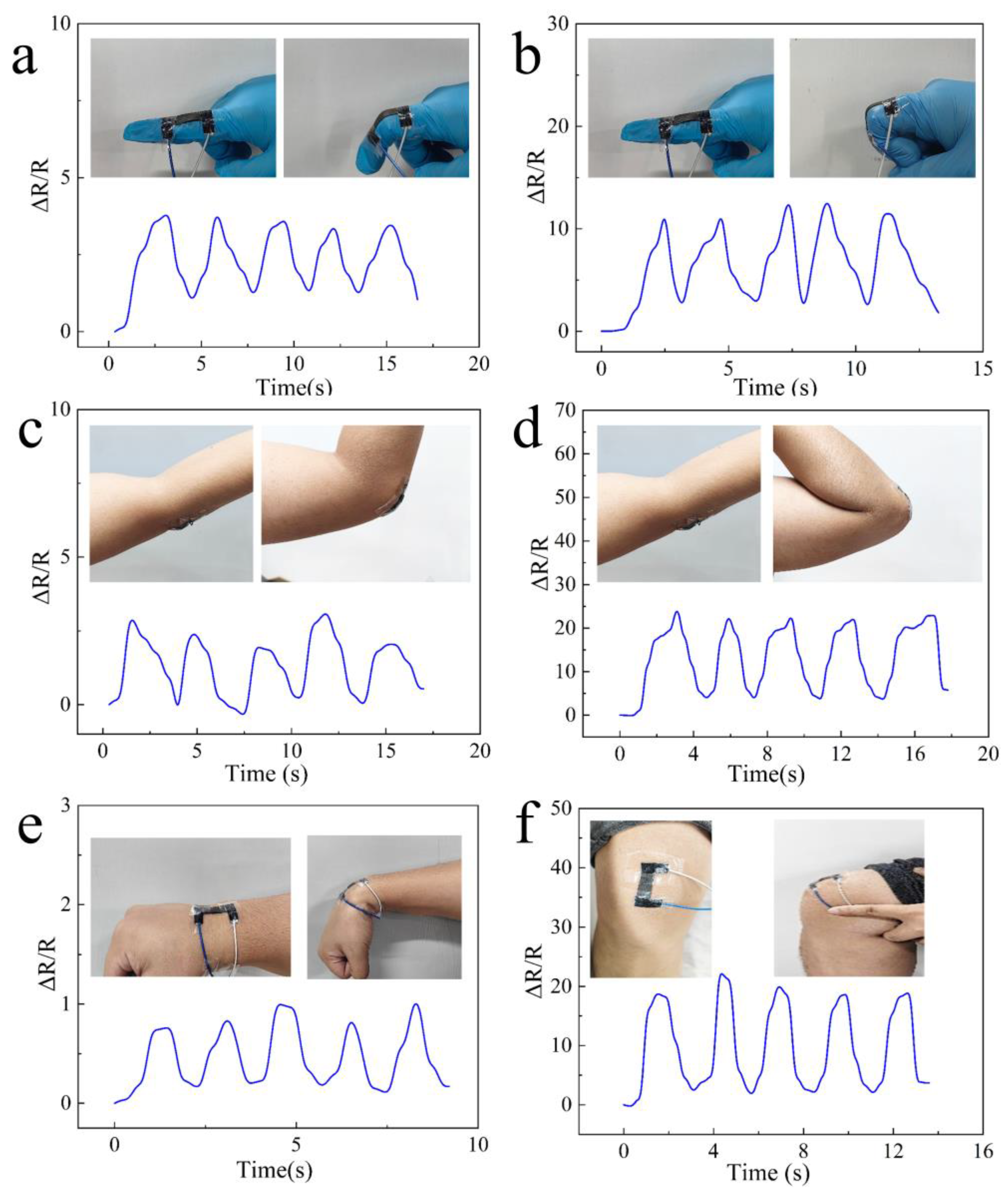
Disclaimer/Publisher’s Note: The statements, opinions and data contained in all publications are solely those of the individual author(s) and contributor(s) and not of MDPI and/or the editor(s). MDPI and/or the editor(s) disclaim responsibility for any injury to people or property resulting from any ideas, methods, instructions or products referred to in the content. |
© 2025 by the authors. Licensee MDPI, Basel, Switzerland. This article is an open access article distributed under the terms and conditions of the Creative Commons Attribution (CC BY) license (https://creativecommons.org/licenses/by/4.0/).
Share and Cite
Wei, Q.; Sun, Z.; Li, X.; Chen, Z.; Li, Y. High Sensitivity and Wide Strain Range Flexible Strain Sensor Based on CB/CNT/PDA/TPU Conductive Fiber Membrane. Appl. Sci. 2025, 15, 1461. https://doi.org/10.3390/app15031461
Wei Q, Sun Z, Li X, Chen Z, Li Y. High Sensitivity and Wide Strain Range Flexible Strain Sensor Based on CB/CNT/PDA/TPU Conductive Fiber Membrane. Applied Sciences. 2025; 15(3):1461. https://doi.org/10.3390/app15031461
Chicago/Turabian StyleWei, Qiong, Zihang Sun, Xudong Li, Zichao Chen, and Yi Li. 2025. "High Sensitivity and Wide Strain Range Flexible Strain Sensor Based on CB/CNT/PDA/TPU Conductive Fiber Membrane" Applied Sciences 15, no. 3: 1461. https://doi.org/10.3390/app15031461
APA StyleWei, Q., Sun, Z., Li, X., Chen, Z., & Li, Y. (2025). High Sensitivity and Wide Strain Range Flexible Strain Sensor Based on CB/CNT/PDA/TPU Conductive Fiber Membrane. Applied Sciences, 15(3), 1461. https://doi.org/10.3390/app15031461




